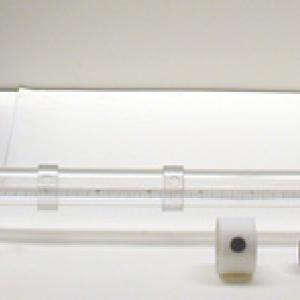College of Liberal Arts & Sciences
3D30.16 - Resonance Tubes - Sliding Piston
Plug the wave generator into the speaker that is mounted at one end of the tube. Slide the movable piston back and forth until the sound of the speaker becomes louder. This position should be 1/2 wave length as measured by the scale attached to the tube.
- Chris Chiaverina, "Performing Acoustic Experiments Using Inexpensive Bluetooth Speakers and Smartphone Signal Generator Applications", TPT, Vol. 60, #2, Feb. 2022, p. 152.
- Zeyu Jason Niu, Duanbin Luo, "Measurement of the Velocity of Sound Through Resonance in Air Columns as a Homemade Experiment", TPT, Vol. 60, #2, Feb. 2022, p. 114.
- James A. Warden, "Measuring the Speed of Sound Without Plumbing", TPT, Vol. 43, #3, May 2005, p. 308.
- Gurbax Singh and Erlend H. Graf, "Redesigned Air-Column Resonance Apparatus", TPT, Vol. 41, #2, Feb. 2003, p. 120.
- R. Cordaro and C. F. Cordaro, "A Demonstration of Acoustical Levitation", TPT, Vol. 24, #7, Oct. 1986, p. 416.
- Brian W. Holmes and Mario L. Capitolo, "Acoustics Demonstration Tube", TPT, Vol. 24, #5, May 1986, p. 297.
- R. D. Edge, "Physics in the Bathtub‐Or, Why Does a Bass Sound Better While Bathing?", TPT, Vol. 23, #7, Oct. 1985, p. 440.
- Franklin R. Muirhead, "Resonance Tube for Measurement of the Speed of Sound", TPT, Vol. 17, #2, Feb. 1979, p. 131.
- "W-255. Resonance Tube", DICK and RAE Physics Demo Notebook, 1993.
- Martin C. Sagendorf, "Sound Tubes", Physics Demonstration Apparatus, 2009, p. 50.
- Jearl Walker, "3.14. Attack of the Australian Cicadas", The Flying Circus of Physics Ed. 2, p. 152.
- Robert Ehrlich, "J.5. Sound Waves in a Variable-Length Tube", Turning the World Inside Out and 174 Other Simple Physics Demonstrations, p. 131 - 132.
Disclaimer: These demonstrations are provided only for illustrative use by persons affiliated with The University of Iowa and only under the direction of a trained instructor or physicist. The University of Iowa is not responsible for demonstrations performed by those using their own equipment or who choose to use this reference material for their own purpose. The demonstrations included here are within the public domain and can be found in materials contained in libraries, bookstores, and through electronic sources. Performing all or any portion of any of these demonstrations, with or without revisions not depicted here entails inherent risks. These risks include, without limitation, bodily injury (and possibly death), including risks to health that may be temporary or permanent and that may exacerbate a pre-existing medical condition; and property loss or damage. Anyone performing any part of these demonstrations, even with revisions, knowingly and voluntarily assumes all risks associated with them.

